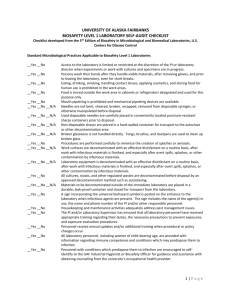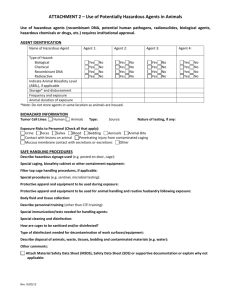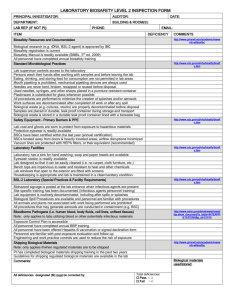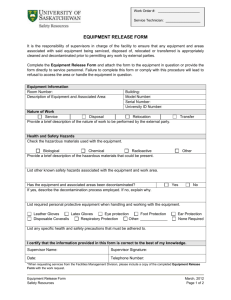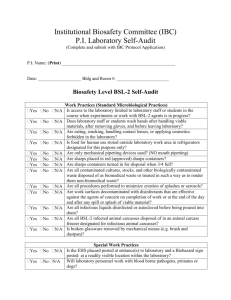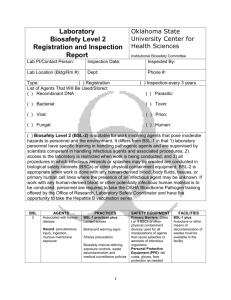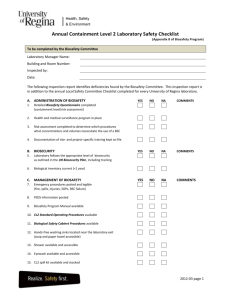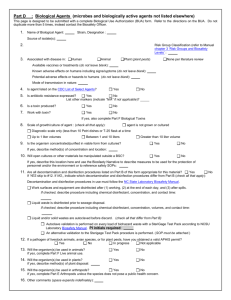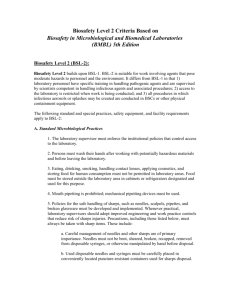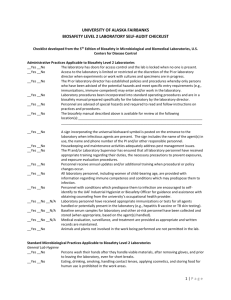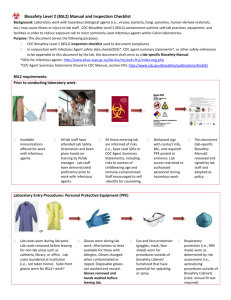Animal - Oklahoma State University Center for Health Sciences
advertisement
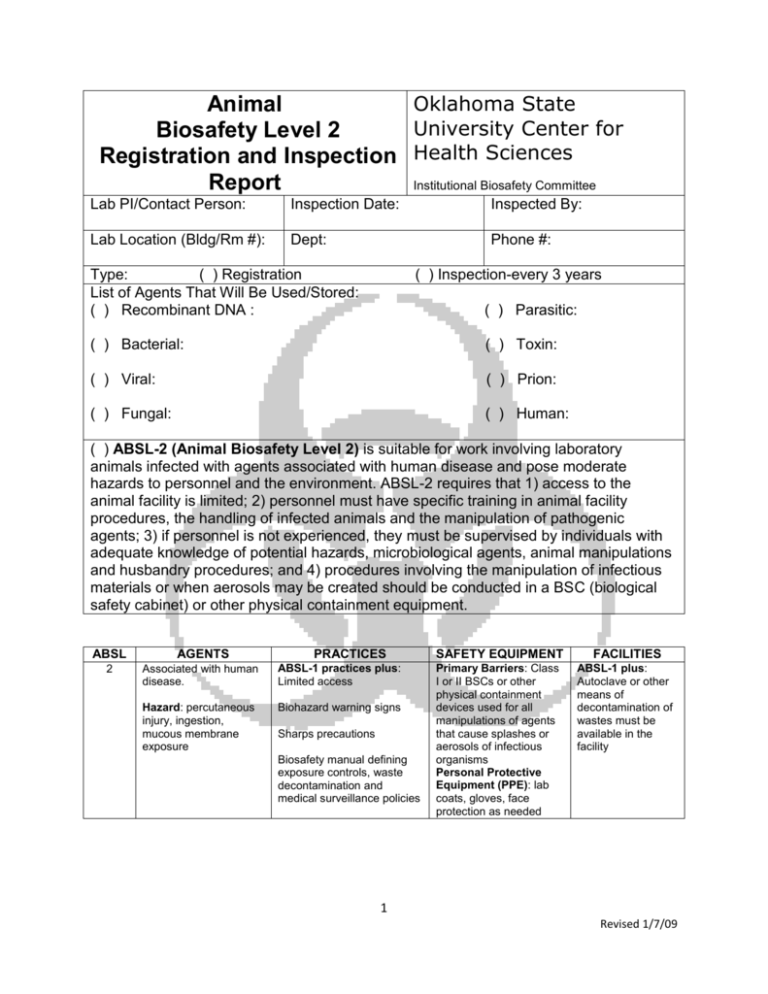
Oklahoma State Animal University Center for Biosafety Level 2 Registration and Inspection Health Sciences Report Institutional Biosafety Committee Lab PI/Contact Person: Inspection Date: Inspected By: Lab Location (Bldg/Rm #): Dept: Phone #: Type: ( ) Registration List of Agents That Will Be Used/Stored: ( ) Recombinant DNA : ( ) Inspection-every 3 years ( ) Parasitic: ( ) Bacterial: ( ) Toxin: ( ) Viral: ( ) Prion: ( ) Fungal: ( ) Human: ( ) ABSL-2 (Animal Biosafety Level 2) is suitable for work involving laboratory animals infected with agents associated with human disease and pose moderate hazards to personnel and the environment. ABSL-2 requires that 1) access to the animal facility is limited; 2) personnel must have specific training in animal facility procedures, the handling of infected animals and the manipulation of pathogenic agents; 3) if personnel is not experienced, they must be supervised by individuals with adequate knowledge of potential hazards, microbiological agents, animal manipulations and husbandry procedures; and 4) procedures involving the manipulation of infectious materials or when aerosols may be created should be conducted in a BSC (biological safety cabinet) or other physical containment equipment. ABSL AGENTS 2 Associated with human disease. ABSL-1 practices plus: Limited access PRACTICES Hazard: percutaneous injury, ingestion, mucous membrane exposure Biohazard warning signs Sharps precautions Biosafety manual defining exposure controls, waste decontamination and medical surveillance policies SAFETY EQUIPMENT FACILITIES Primary Barriers: Class I or II BSCs or other physical containment devices used for all manipulations of agents that cause splashes or aerosols of infectious organisms Personal Protective Equipment (PPE): lab coats, gloves, face protection as needed ABSL-1 plus: Autoclave or other means of decontamination of wastes must be available in the facility 1 Revised 1/7/09 A. Standard Microbiological Practices for ABSL-2 Yes No Comments 1. Has the protocol been approved by the IACUC? 2. Is a biosafety manual specific to the animal room prepared and available for consultation by lab personnel? 3. Is access to the animal room limited to only those persons required for program or support purposes? 4. Is PPE (personal protective equipment) available as determined by the risk assessment? 5. Are hand washing facilities available and do personnel wash hands after removing gloves and before leaving the animal or procedure rooms? 6. Are eating, drinking, smoking, applying cosmetics and food storage forbidden in animal or procedure rooms? 7. Are mechanical pipetting devices used and mouth pipetting prohibited? 8. Are policies and equipment in place for working with sharps (needles, scalpels, pipettes, broken glassware)? a. Is there a sharps container present? b. Is there a box for broken glass present? c. Are alternatives to sharps considered for such procedures as parenteral injection, blood collection, or aspiration of fluids from laboratory animals or diaphragm bottles? d. Are non-disposable sharps placed in closed hard walled containers for transport to be decontaminated? 9. Is care taken to minimize the creation of splashes and aerosols? 10. Are work surfaces decontaminated with an appropriate disinfectant after completion of work and after any spill of potentially infectious material? 11. Are all wastes from the animal room decontaminated before disposal and 2 Revised 1/7/09 then transported in leak-proof covered containers and disposed of in compliance with all applicable regulations? 12. Is appropriate signage posted at the entrance to the laboratory to include the universal biohazard symbol? Note: Posted information must include the following: the animal biosafety level, general occupational health requirements, PPE requirements, the responsible person’s name, telephone number, agent information, and required procedures for entry/exit. 13. Is an effective pest management program in place? 14. Has the PI (Principal Investigator) provided appropriate training to animal care, laboratory and support personnel in regards to job duties, animal care and handling, spill clean-up, necessary precautions to prevent exposures, exposure evaluation procedures and records retention for incidents? a. Are annual updates and change information provided? b. Are records kept for all hazard evaluations and employee training? 15. Is an appropriate medical surveillance program in place (including allergy prevention), if necessitated by the risk assessment? 16. Is there a policy to prevent the presence of animals and plants not associated with the study? B. Special Practices for ABSL-2 Yes No Comments 1. Have personnel been provided medical surveillance program and offered appropriate immunizations for agents that may be present? 2. If deemed necessary by the risk assessment, is there a policy/procedure in place describing the collection and storage of serum 3 Revised 1/7/09 3. 4. 5. 6. samples from at-risk personnel? Are there procedures in place for the routine decontamination of all potentially infectious materials, animal waste, husbandry equipment and medical equipment before moving materials outside of use area? a. Is there a supply of agent for appropriate decontamination solution ready for use? b. Is there a container of disinfectant in the BSC? c. Is waste placed in durable, leakproof, labeled containers and the outer surface disinfected prior to transport outside of use area? d. Has a written waste program been developed? Are incidents that result in exposure to infectious materials immediately evaluated and treated according to procedures described in the lab biosafety manual? Are equipment, cages, and racks decontaminated in a manner that will minimize contamination of other areas? Are all procedures involving a high potential to produce aerosolization* of infectious materials conducted in a BSC or other physical containment device? a. Have restraint devices and practices been considered to reduce the risk of exposure during animal manipulations? * aerosolization can occur from: pipetting, centrifuging, grinding, blending, shaking, mixing, sonicating, opening containers of infectious materials, inoculating animals intranasally, necropsy of infected animals and harvesting infected tissues from animals or eggs. C. Safety Equipment (Primary Barriers and PPE) Yes No Comments 1. Has a risk assessment been 4 Revised 1/7/09 2. 3. 4. 5. 6. performed and used to determine appropriate type of PPE? Are BSCs, other physical containment equipment or PPE used when procedures with a potential for creating infectious aerosols are used? When indicated by risk assessment are animals housed in primary biosafety containment equipment? Are lab coats, gowns smocks or other protective clothing worn while working with hazardous materials or animals? a. Are they removed before entering non-laboratory areas? b. Is there a procedure for disposal or laundering of protective clothing? Are eye and face protection (goggles, mask, face shield) used for anticipated splashes/sprays and when manipulations of infectious material and /or animals must be performed outside of a BCS or other containment device? a. Is eye and face protection disposed after use or decontaminated before reuse? b. Is respiratory protection worn based on risk assessment? Are gloves worn and special care taken to avoid skin contamination when working with infectious materials or animals? D. Laboratory Facilities (Secondary Barriers) Yes No Comments 1. Are all laboratory doors self-closing and have locks? a. Is access restricted? 2. Does the lab have a sink available for hand washing preferably near the exit door? 3. Is the laboratory designed for easy cleaning and decontamination? 5 Revised 1/7/09 a. Water resistant surfaces b. Penetrations are sealed c. Floors slip and chemical resistant 4. Are bench tops made of material impervious to water and resistant to heat, organic solvents, acids, alkalis and other chemicals? 5. If the lab has windows, are they sealed and resistant to breakage? External windows are not recommended. 6. Is the animal room under negative pressure (i.e. direction of airflow is inward)? a. Is exhaust air discharged to the outside? 7. Are horizontal surfaces (light fixtures, air ducts, utility pipes) minimized to facilitate cleaning and accumulation of debris and fomites? 8. Are floor drains maintained and filled with water and /or appropriate disinfectant to prevent movement of vermin and gases? 9. Can cages be decontaminated prior to washing? a. Does the cage washer have a final rinse temperature of 1800F? 10. Is illumination non-glaring and antireflective? 11. Are BSCs located away from doors, windows that can be opened, heavily traveled areas, other possible airflow disruptions and certified at least annually? 12. Are vacuum lines protected with HEPA filters or their equivalent? Note: May require a liquid disinfectant trap 13. Are an eyewash station and emergency shower readily available? 14. Are lab chairs covered with a nonporous (no fabric) material that can be easily decontaminated? 6 Revised 1/7/09 15. Is there a method available for decontaminating wastes (e.g. autoclave, chemical disinfection, incineration or other validated decontamination method)? INSPECTION FINDINGS Checklist Number Deficiencies Registration/Inspection Disposition: for ABSL-2 work Corrective Action Status □ Approved for ABSL-2 work □Provisionally approved Comments: IBC Representative Signature: IBC Representative Signature: Date: Date: NOTES: A. Laboratory Specific Biosafety Manual The CDC’s Biosafety in Microbiological and Biomedical Laboratories (BMBL) can be useful to the PI in writing his/her biosafety manual. It can be found at this URL: http://www.cdc.gov/od/ohs/biosfty/bmbl5/bmbl5toc.htm The manual should be designed to: 1) protect employees, visitors, and the surrounding community from the health hazards in the laboratory; 2) meet applicable federal, state, and institutional guidelines or requirements; 3) define responsibilities for laboratory safety; 4) provide laboratory specific standard operating procedures; 5) provide information about safe work practices, safety equipment, and personal protective equipment; and 6) serve as a resource for laboratory staff. Key Elements of a Laboratory Specific Biosafety Manual (as applicable): 7 Revised 1/7/09 Responsibilities Safe handling of sharps Identification of biohazards Waste processing Entry requirements Disinfection/spill response General laboratory safety practices Emergency procedures Identification of operations that require Training requirements and documentation engineering controls and safety equipment Pest control management Administrative controls Transport of infectious materials protocol Animal Safety Practices (if applicable) Security The above information was extracted from a guidance document published by the Centers for Disease Control (CDC); see reference #4 below. More specific information regarding each of the key elements above may be found on the OSU-Stillwater Biosafety webpage at http://compliance.vpr.okstate.edu/IBC/gs-biological.aspx . B. Other helpful references 1. NIH Guidelines for Research Involving Recombinant DNA Molecules http://www4.od.nih.gov/oba/ibc/ibcindexpg.htm 2. Bloodborne Pathogen regulation http://www.osha.gov/pls/oshaweb/owadisp.show_document?p_table=STANDARDS&p_i d=10051&p_text_version=FALSE 3. An excellent Powerpoint presentation by the CDC on biosafety http://www.cdc.gov/od/ohs/pdffiles/Module%202%20-%20Biosafety.pdf 4. Biosafety Manual guidance document published by the CDC http://www.selectagents.gov/resources%5CDevelopment%20of%20a%20Biosafety%20 Plan.pdf. 8 Revised 1/7/09
